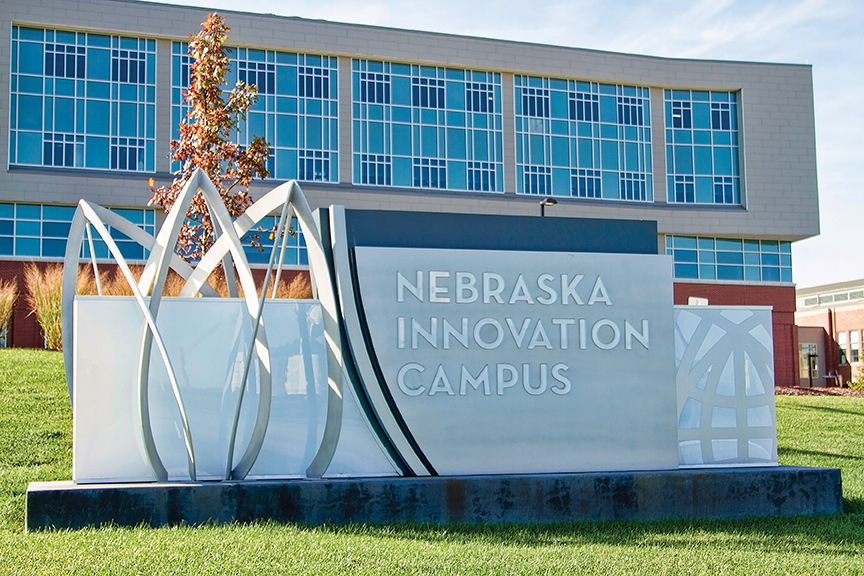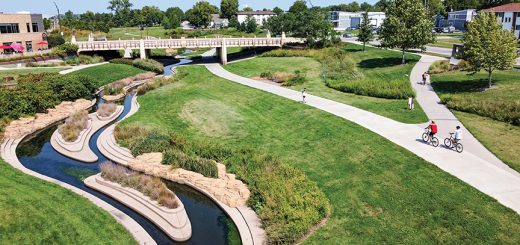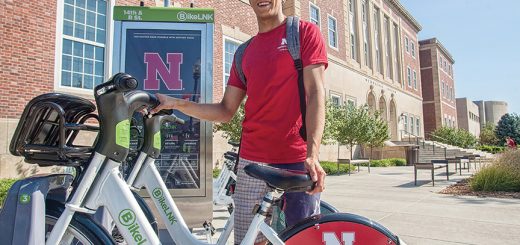Nebraska Innovation Campus

Nebraska Innovation Campus is dramatically altering the landscape north of downtown Lincoln. This new research campus, focused on interfacing private business with university programs, aims to change the city itself. From all appearances, this change is taking root in powerful ways. According to executive director Dan Duncan, the physical campus will follow a live/work/play model that includes not just offices and labs but amenities like restaurants and shops to meet employees’ demands. “We’re striving for the Innovation Campus to be part of the Lincoln ecosystem and not an island within the ecosystem.” Phase I of its development plan was completed in summer 2015, creating 380,000 square feet for offices, labs, greenhouses, prototyping spaces and the food processing pilot plant.
“Nebraska Innovation Campus is a physical space, but it’s also an idea or culture change,” Duncan claims. Supporting this mission is NIC’s commitment to zero-waste and sustainability, as shown in its LEED Silver standard buildings, recycling and composting efforts and its closed-loop energy system built in collaboration with a nearby water treatment plant. The award-winning innovative system, based on geothermal technology, provides heating and cooling for 1.8 million square feet of space throughout the campus.
Unique spaces that intend to inspire creative engagement, the NIC complex of buildings lies north of the University of Nebraska’s City Campus between 14th and 17th streets—previously home to the Nebraska State Fairgrounds. When the fair moved to Grand Island in 2010, the Nebraska Innovation Development Corporation implemented plans to remodel some of the state fair buildings and demolish others on the way to creating Innovation Campus.
The first step towards that goal was renovating the old 4-H Building and constructing an adjacent companion building. The two structures form Innovation Commons and are home to a conference facility that includes a 400-seat, two-story auditorium linked electronically to Nebraska Educational Telecommunications, allowing NET to broadcast from the space. The Nebraska Alumni Association manages the conference center, which will be available to groups from the university and the greater community. The university retained ownership of the conference side of the building, but the rest of the space in the commons buildings is privately owned.
Nebraska Innovation Studio is a ‘maker space’ where inventors and innovators are encouraged to explore and develop their ideas. Members and students have access to laser and water jet cutters, a machine shop; equipment for woodworking, metalworking, textile production, electronics, plastics and welding, as well as engineering and design software. Like a rec center, members pay for access and complete training that prepares them to use the sophisticated tools to develop ideas into new products. Classes are offered with no prerequisites or restrictions and include lab access. Course topics vary widely—from design software, laser cutting, 3D scanning and printing, to textile fabrication, electronics production and mechanical design.
A gallery space, Cooper Foundation Makers Gallery, provides exhibition space for ‘member made’ projects and student artworks and images from the quilt museum on East Campus. According to NIC’s communications director Kate Engle, the art spaces extend NIC’s mission, encouraging interaction. “Offering these new exhibition spaces does on a small scale what we hope the whole campus does—encouraging diverse backgrounds, skill sets and people to have conversations. The spaces also help create a campus where talent wants to be.”
NIC’s grounds make use of another historic structure left from State Fair days. The Industrial Arts Building is now home to the Food Innovation Center.
The façade of the building has been preserved and restored but the interior rebuilt to serve the needs of UNL’s Food Science Department. The four-story laboratory building is attached to the north side of the old building, and the renovated original structure retains its historic look.
This structure now houses UNL’s Food Science Department, providing both lab space and classrooms under one roof. Students and faculty interact with researchers from ConAgra, the major food research and processing company headquartered in Omaha. ConAgra has moved its entire popcorn-breeding program to UNL’s East Campus. The genetic work is done in UNL labs, with a field test site at 84th and Havelock. An additional partnership, the 3M materials science company has joined the Alliance for Advanced Food Sanitation. A research collaboration between 3M and UNL’s Food Processing Center initiated this project. Director of the alliance, Angela Anandappa, says “The university has a rich history of working well with industry, especially with the food industry. 3M’s passion is about investing in innovations that improve the lives of people, and we share in this desire.” Greg Anderson, vice president of 3M’s research laboratory, adds “Food safety is a global megatrend that affects everyone. As a member of the Alliance, we can be part of a collaborative environment focused on creating and disseminating improved sanitation approaches that benefit customers, industry and society at large.”
ConAgra and 3M’s partnership with the NIC are example of the kind of innovation that’s coming to Lincoln. “Food, fuel and water are Nebraska’s strengths,” according to Wendy Birdsall of the Chamber of Commerce. The Daugherty Global Water for Food Institute is another, now headquartered in the new Innovation Commons on the NIC campus.
The non-traditional Water for Food Institute network embraces relationships with national and global entities: public sector institutions, private sector partners, other universities and NGOs. The Water for Food Institute also houses the Nebraska Water Center, established over fifty years ago. The Water Center focuses on research and outreach programs that work to make UNL a premiere institution in the study of agricultural and domestic water use. Its expert staff operates a state of the art lab that uses the latest instrumentation to measure chemicals in water, specializing in trace organics. See our story on page 36 for more information.
Further reflecting the hybrid nature of NIC’s public/private collaboration, Spreetail, a rising e-commerce company, has taken up residence in the Innovation Commons building. Spreetail employs about 160 people, two-thirds of them on campus. Spreetail’s floor plan hints at the nature of its business, with wall panels made of shipping containers, polished concrete floors, exposed ceilings and design elements that incorporate wood from pallets that are used to store products in the company’s distribution centers.
As a ‘millenial-style’ company, Spreetail offers its employees video games, beer taps and open space. Director Brett Thome says the company wanted to create a casual workplace but one that isn’t too much fun. “We don’t want to be the place everyone wants to work,” he says. “We want to be the place where 5 percent of the right kind of people want to work.” As massive e-commerce companies like Amazon and Wal-Mart continue to grow, Spreetail intends to stay small and keep goals reasonable. The company aims to increase revenue to $1 billion and hopes to grow its workforce from 160 to 800 employees by 2022. Thome feels that the e-commerce market is growing at such a rapid pace that “if we get one-tenth of 1 percent in 2022 that’s $1 billion.”
NUtech Ventures’ NMotion, a mentor-driven business accelerator, is an “off campus” NIC project. Located in the Haymarket, the organization provides 14-week classes to entrepreneurs who are developing innovative software. An additional accelerator, NMotion Hardware, on NIC’s physical campus, is suited for startups or existing manufacturers that want to develop physical products. Companies using NMotion Hardware are able to use the NIC Innovation Studios to build product prototypes.
NIC has also recently partnered with the Children’s Center for the Child & Community, a creation of Omaha’s University of Nebraska Medical Center. The goal of Children’s Center is to find public health solutions to address pervasive children’s health issues like childhood obesity, food insecurity, injury prevention and poverty through partnerships with Nebraska towns. Additionally, the center aims to increase its role in public advocacy and development of health care policies for children. A seasoned pediatrician, Karla Lester, leads the program. “There are a lot of positive efforts happening, but there hasn’t been a hub of coordination to ensure the biggest impact,” says Lester. “Children’s is a high-level partner that has the expertise and infrastructure to offer communities the support they need.” The Children’s Center offers a primary example of how NIC partners are already making a statewide impact.
The target for the full build-out of Nebraska Innovation Campus is 2.2 million square feet of space by 2037. The completed project could employ up to 5,000 people—one-third by UNL and two-thirds by private businesses and non-UNL employers.
Wendy Birdsall, executive director of the Lincoln Chamber of Commerce, sees big, long-term value in Nebraska Innovation Campus for both the university and the Lincoln community. “It’s a investment in the future,” she says. Dave Landis, director of Lincoln’s Office of Urban Development, is likewise enthusiastic. “It provides the prospect of creating economic opportunities on the cusp of the future,” Landis says. “It’s an invitation to make something for which there is no competition yet.”
Director Dan Duncan believes that Innovation Campus itself is on the cusp of the future. “We’re a start-up company,” Duncan said. “We’re learning as we go, making changes as we go. What’s good about that is that it creates some uneasiness and a healthy tension.” This tension continues to drive creativity and innovation at the NIC campus and throughout the community, a winning partnership for the university and the city of Lincoln.




Recent Comments